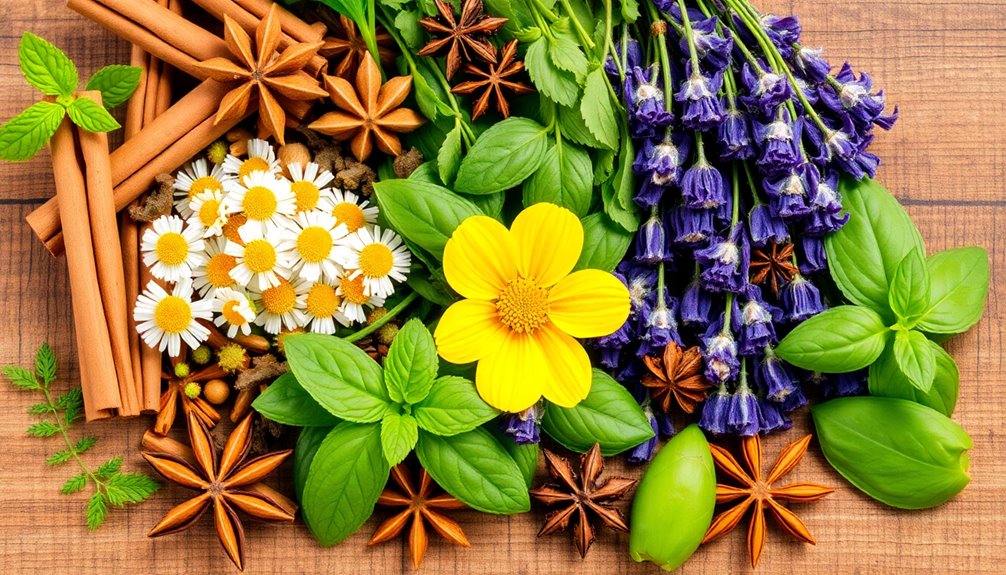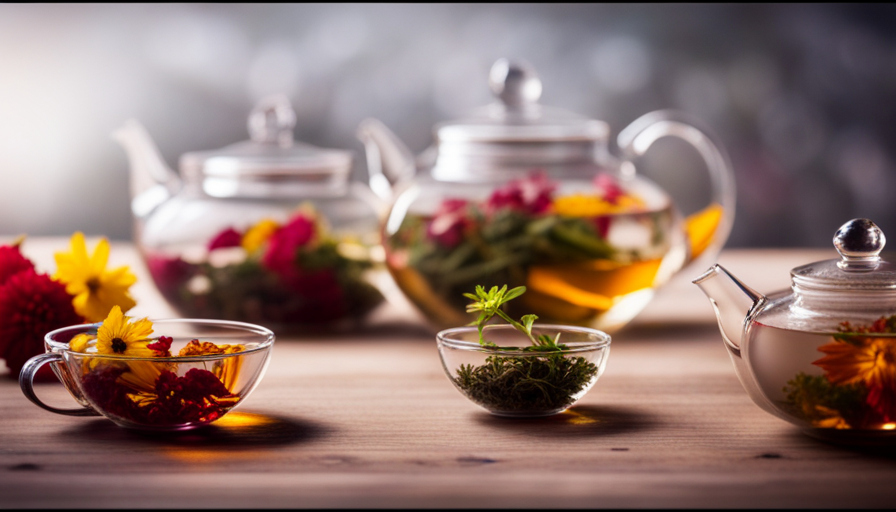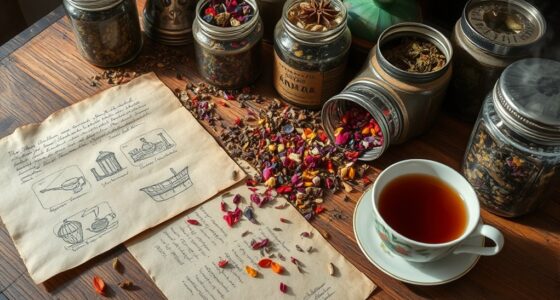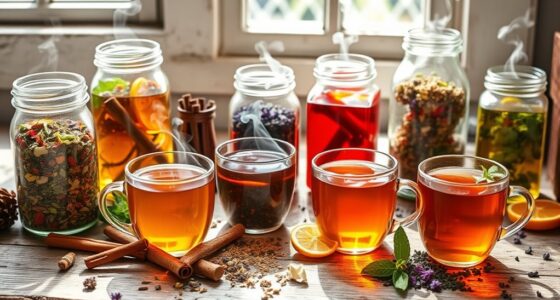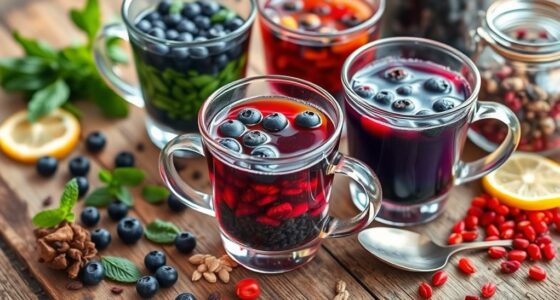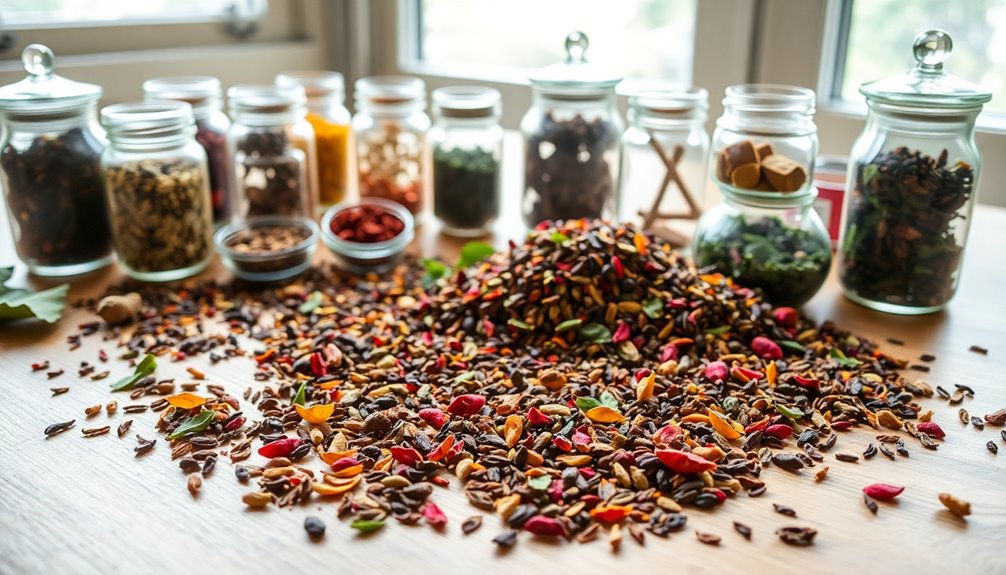If you're making DIY tea blends, you can enjoy a wonderful variety of herbs and spices! Here are some favorites:
- Chamomile: Calms your mind.
- Mint: Refreshes and aids digestion.
- Rooibos: Earthy and caffeine-free.
- Ginger and Cinnamon: Add warmth and spice.
Don't overlook unique choices like hibiscus for tangy flavor or lemon balm for a citrusy twist. These ingredients not only taste amazing, but they also promote wellness with their health benefits. With so many options, exploring flavors is super fun! Stick around to discover the best brewing tips and more delightful combinations!
Key Takeaways
- Chamomile is a popular base herb for its calming properties, perfect for soothing blends.
- Mint adds a refreshing flavor and aids digestion, making it ideal for summer teas.
- Ginger provides warmth and supports digestion, especially beneficial in fall and winter blends.
- Hibiscus offers a tangy taste and is rich in antioxidants, promoting heart health.
- Cinnamon enhances flavor with warm notes and can be paired with various herbs for depth.
Introduction
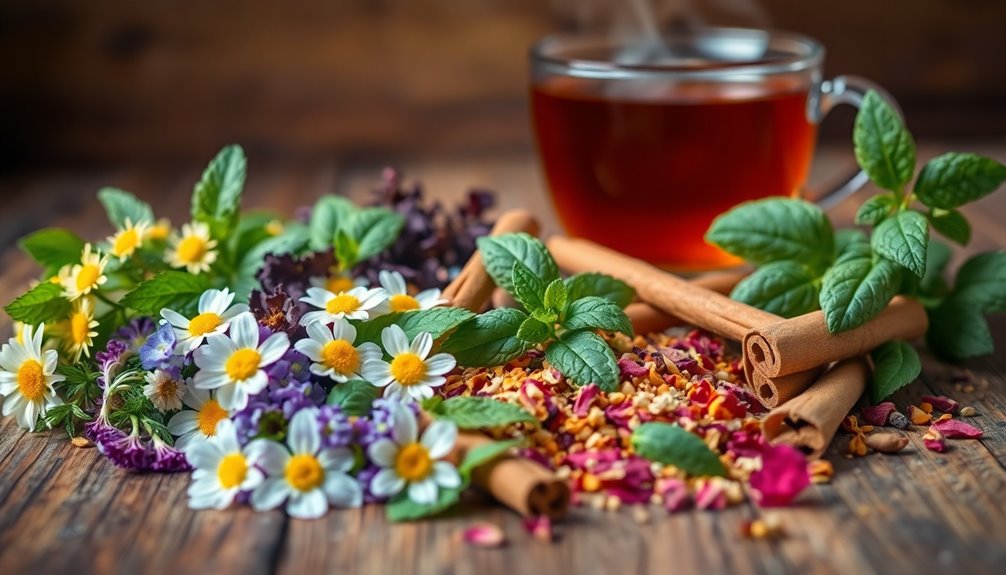
When it comes to creating your own tea blends, the possibilities are endless. You can mix and match different herbs to make delicious flavors that fit your taste.
Imagine sipping a cup of chamomile tea to relax after a long day or enjoying refreshing peppermint when your tummy feels off. The right herbal blends can also bring you some extra health benefits, as many herbal teas are known for their medicinal properties.
Here are some commonly used herbs for your blends:
- Chamomile for calmness
- Mint for freshness
- Lemon balm for a light citrusy touch
- Rooibos for a sweet, earthy flavor
You can even spice things up with:
- Cinnamon for warmth
- Ginger for a zesty kick
To make the perfect blend, remember this simple formula: Start with a base herb, add a star herb for flavor, and throw in an accent for a special twist. You might also consider adding yerba mate to your blends for an extra boost of energy and antioxidants.
Fresh herbs work best, so use 2 teaspoons of fresh herbs for every 6 ounces of water. Don't be afraid to experiment! Each cup can be a new adventure, so gather your family, and enjoy making your own unique tea blends together!
Herbs for Seasonal Wellness
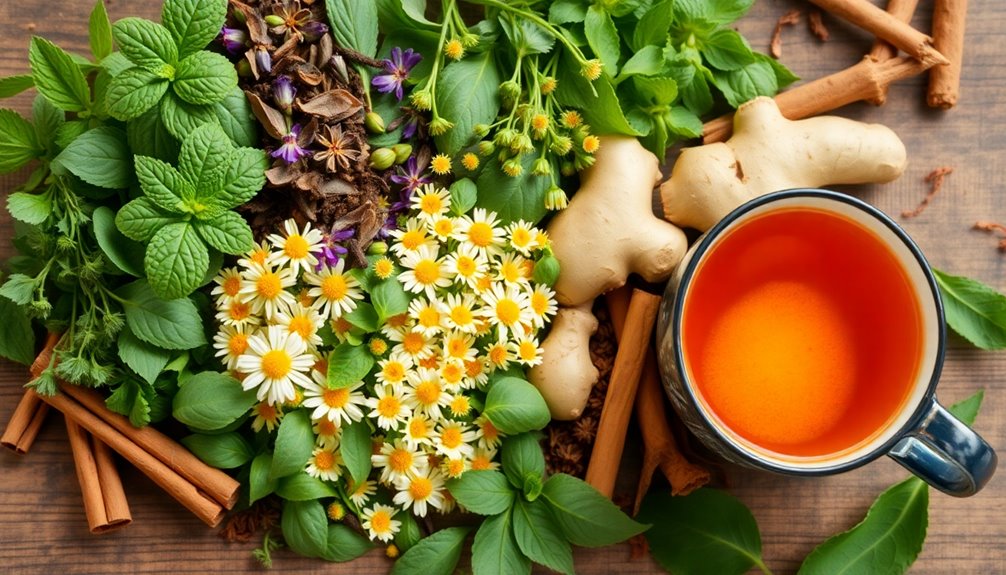
Herbs play a crucial role in supporting seasonal wellness, helping you navigate the changing demands of your body throughout the year. Each season brings unique challenges, and using herbal tea blends can make a big difference!
- Spring & Summer: Lemon balm is a lovely choice. It helps you relax and eases anxiety when stress creeps in during busy days. Additionally, aromatherapy can trigger the release of neurotransmitters like serotonin and dopamine, enhancing overall well-being. Research shows that temporary hearing loss can also heighten stress levels, making relaxation even more essential.
- Fall & Winter: Chamomile shines here! This versatile herb promotes sleep and relaxation, perfect for those longer nights when you want to snuggle up.
- Winter: Ginger root is your go-to! Its warming qualities aid digestion and help you feel cozy, making it a must-have for chilly evenings.
- Summer: Don't forget peppermint! It adds a refreshing flavor to your tea and helps cool your body on hot days while also supporting digestion.
Incorporating these seasonal ingredients into your herbal tea blends can brighten your day and keep you feeling great. Additionally, herbs like chamomile are known for their soothing properties, making them particularly beneficial during times of stress or anxiety.
Herbs Enhance Seasonal Health Benefits
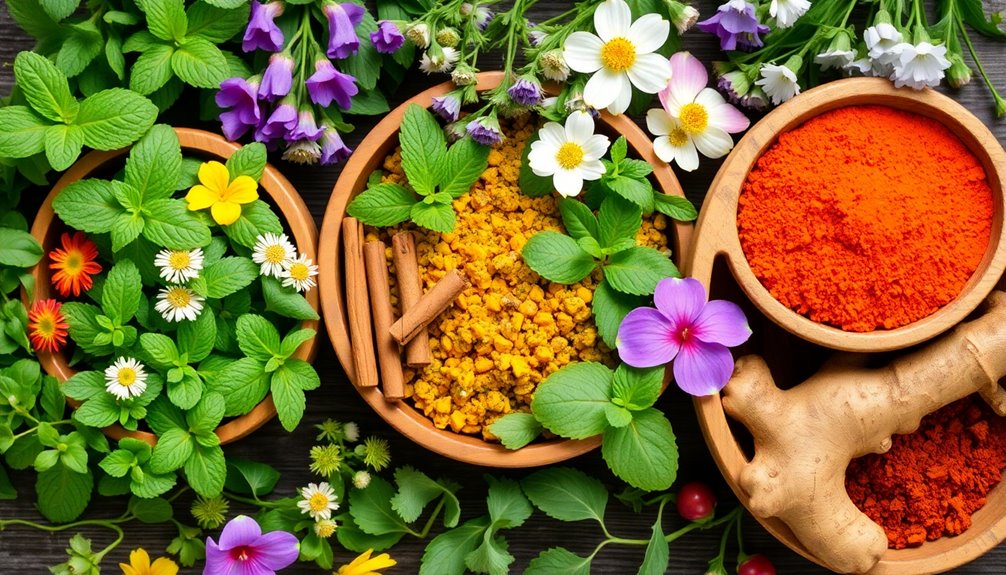
Enhancing your seasonal health benefits can be as simple as incorporating specific herbs into your tea blends. Seasonal herbs like chamomile and lemon balm can promote relaxation and help reduce anxiety during the busy spring and summer months.
They're perfect for those times when you need to unwind after a fun-filled day!
In fall and winter, reach for immunity-boosting herbs such as Echinacea and elderberry. These herbs help strengthen your body's defenses against pesky colds and flu, keeping you feeling your best.
When the temperatures drop, warming herbs like ginger and holy basil come to the rescue, supporting digestion and circulation. They provide comforting warmth during chilly days, making your herbal tea blend a cozy treat.
Don't forget about fresh herbs like mint and lemongrass! These invigorating flavors are ideal for hot summer days, helping you stay refreshed and hydrated. Additionally, incorporating herbs like ginger can also promote digestive health, complementing your tea blends for overall wellness.
Using seasonal herbs not only enhances the flavor of your tea but also aligns with your body's natural rhythms.
Uncommon Herbs for Flavor Enhancement
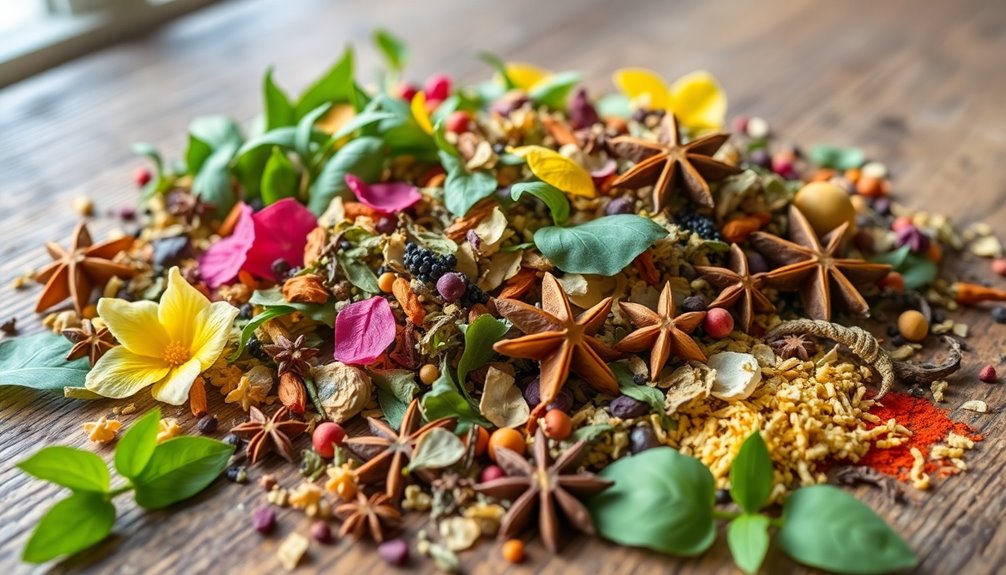
Discovering uncommon herbs can elevate your tea blends in surprising ways. Imagine sipping a cup of herbal tea that bursts with unique flavors!
Let's explore some delightful options for your homemade tea blends.
- Basil Mint gives a sweet and minty taste, perfect for refreshing tea mixes on warm days. This herb is also known to enhance skin health, making it a great addition to your wellness routine. Additionally, its hydration importance can further support overall health during warm weather.
- Bee Balm brings a citrus-like flavor and calming properties, making it ideal for soothing herbal blends.
- Hibiscus adds a tangy, tart flavor along with a vibrant color, plus it's rich in antioxidants for heart health! Its antioxidants can combat oxidative stress, enhancing the overall health benefits of your tea.
- Lemon Myrtle offers a strong lemon flavor without the acidity, brightening up your tea with a sunny twist.
- Anise Hyssop combines sweet, licorice notes with a hint of mint, making your tea blends exciting and aiding digestion.
Using these uncommon herbs can really enhance the flavor of your herbal teas. Additionally, many of these herbs and their natural antibacterial properties can provide health benefits beyond just taste.
Dried herbs can be easily mixed to create your own special blends. So, gather your favorite herbs, get creative, and enjoy the delightful journey of flavor enhancement in every cup!
Your family will love the surprises each sip brings!
Herb Safety and Allergies
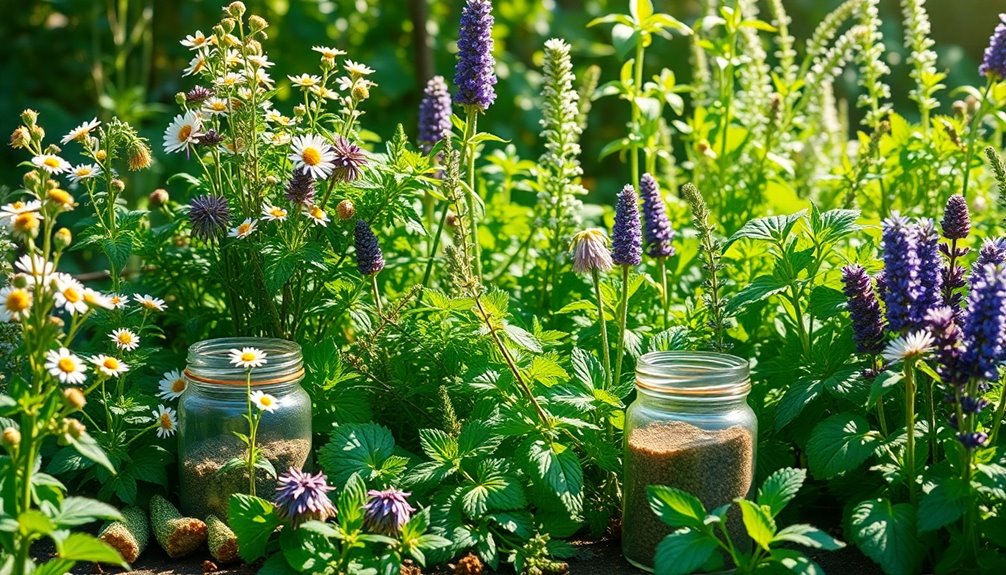
When crafting your unique tea blends, it's important to keep safety in mind. You want your tea time to be joyful and safe for everyone!
Start by researching each herb you plan to use. Some common herbs, like chamomile and lavender, can cause allergic reactions in certain individuals. To help you discover any sensitivities, consider patch testing before using herbal blends. This simple method can check for allergic reactions on your skin.
If you're pregnant or breastfeeding, it's wise to consult your healthcare provider before diving into herbal blends, as some herbs may not be safe for you.
Also, keep a detailed record of the herbs you use. This way, if any adverse effects pop up, you can easily share this information with a healthcare professional.
Be cautious with herbs known for their strong medicinal properties, like Echinacea and valerian root. They can interact with medications or worsen existing health conditions.
Practical Applications
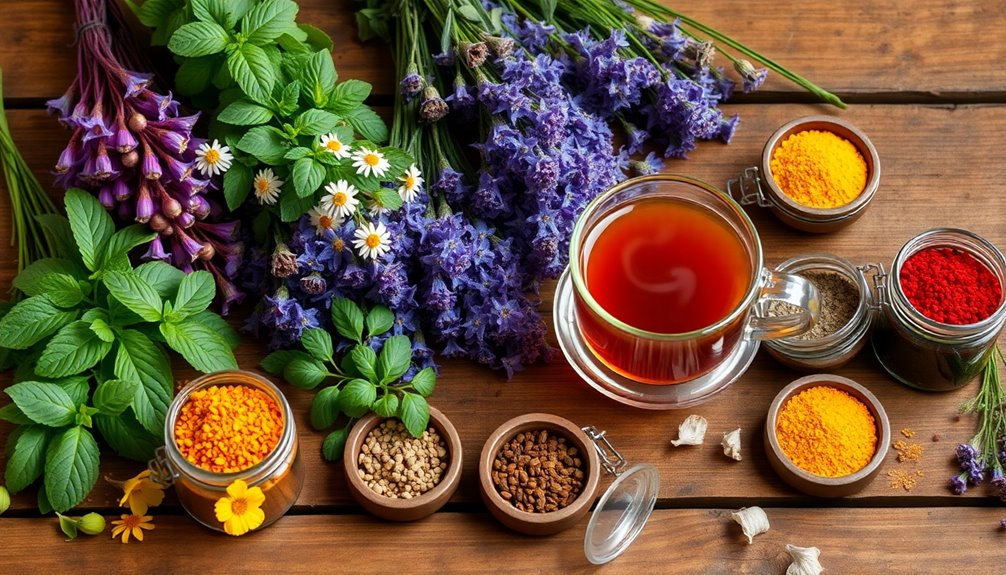
Creating your own tea blends opens up a world of flavors and benefits that can cater to your individual tastes and needs. You can enjoy the calming effects of chamomile, the refreshing zing of peppermint, or the warming spice of ginger. Essential oils can also enhance the aromatic experience of your tea blends. Additionally, incorporating essential oils for relaxation can elevate your tea experience by promoting a calming environment.
Here's how to get started:
- Choose Your Herbs: Think about what you want from your tea. Use dried herbs like chamomile, or spices like cinnamon, to create a delightful blend.
- Mix Ratios: A good starting point is 1 part star ingredient, like licorice root, to 2 parts base, such as chamomile, with 1 part accent, like cinnamon.
- Brewing Tips: If you're using dried herbs, measure about 1 tablespoon for every 8 ounces of water. For fresh herbs, use 2 teaspoons per 6 ounces.
- Storage: Keep your dried blends in airtight containers, away from light and moisture, to last up to a year!
- Temperature Matters: Experiment with water temperatures: 200°F for black teas and around 190°F for green.
- Health Benefits: Many herbs, like chia seeds(https://example.com/chia-seeds-health-benefits), offer impressive health advantages, making them a great addition to your tea blends.
With these tips, you'll create delightful herbal blends that you and your family will love! Enjoy your tea journey!
Frequently Asked Questions
What Herbs to Blend for Tea?
When blending herbs for tea, consider chamomile for relaxation, peppermint for digestion, lemon verbena for a citrusy kick, lavender for soothing effects, and ginger for warmth and flavor. Experiment to find your perfect mix!
What Are Good Combinations for Tea?
You can create delightful tea combinations by mixing chamomile with lavender for relaxation, lemon verbena with lemongrass for refreshing citrus, or mint with rose geranium for a chocolate treat. Explore these blends for unique flavors!
What Spices Go Well in Tea?
When you're exploring spices for tea, try cinnamon, ginger, and cardamom for warmth. A pinch of star anise or cloves adds depth. Hibiscus brings tartness, while dried citrus peels add brightness and freshness to your blend.
How Many Herbs Should Be in a Tea Blend?
You should aim for three to five herbs in your tea blend. This balance creates a harmonious flavor profile, allowing each herb to shine without overpowering the others, making your tea experience enjoyable and complex.
Conclusion
Now that you know about the best herbs and spices for your DIY tea blends, it's time to get creative! Mix and match to find your favorite flavors, and enjoy the warmth and comfort they bring. Remember, making tea can be a fun family activity, so gather everyone together and experiment with different combinations. Sip your delicious creations and feel the joy of crafting something special. Cheers to your new tea adventures!

